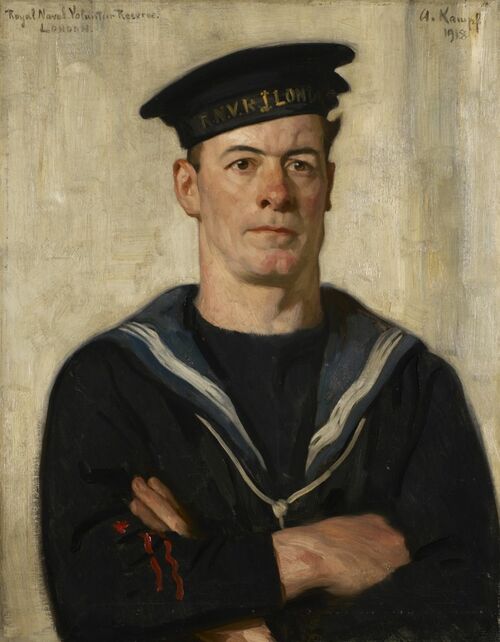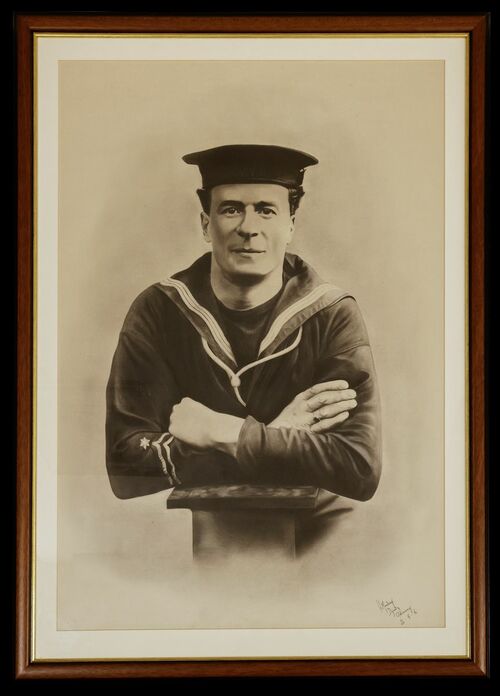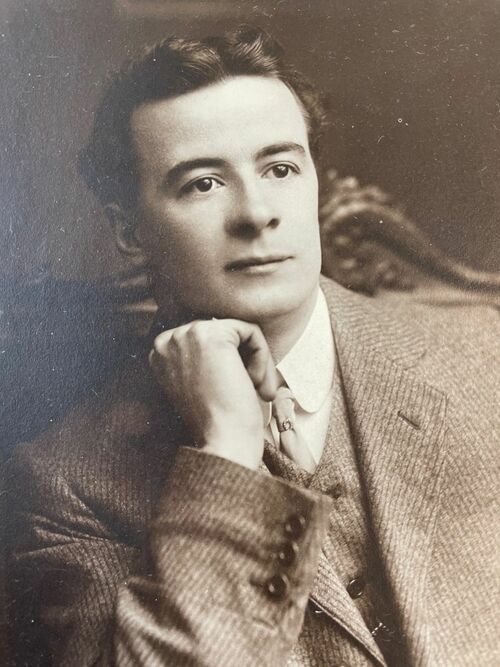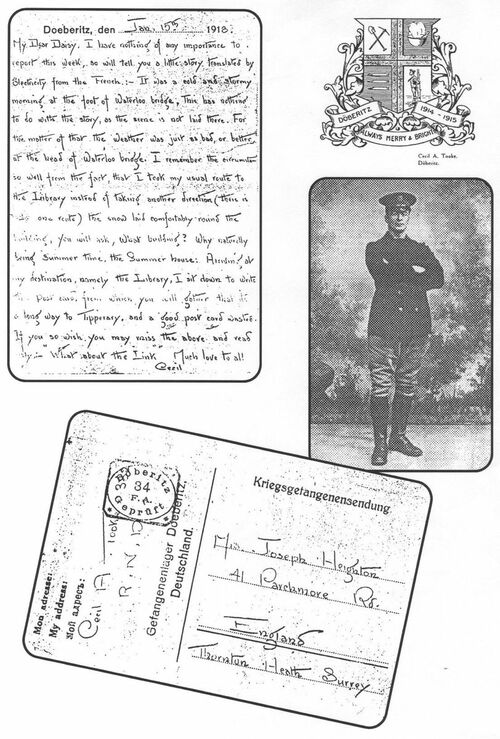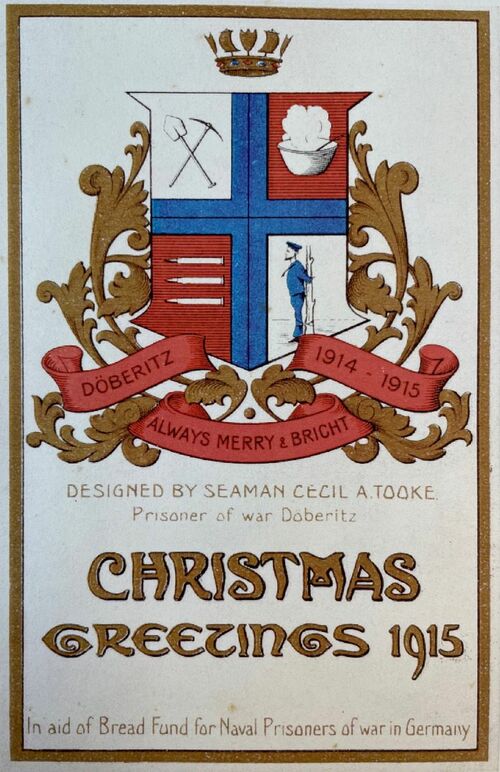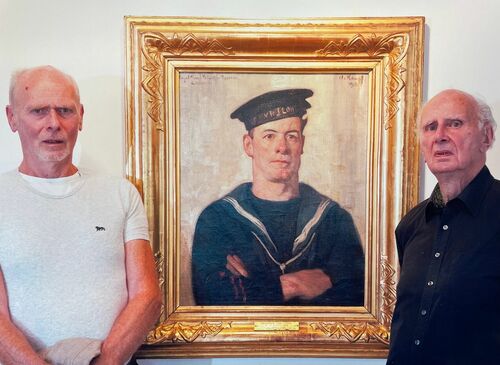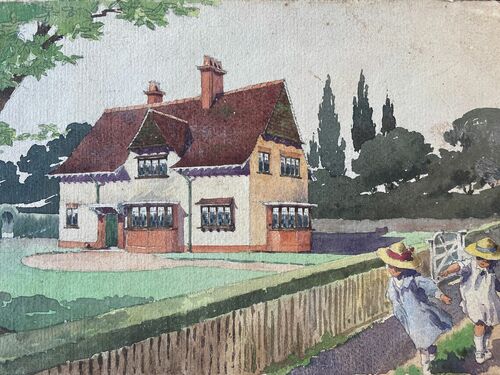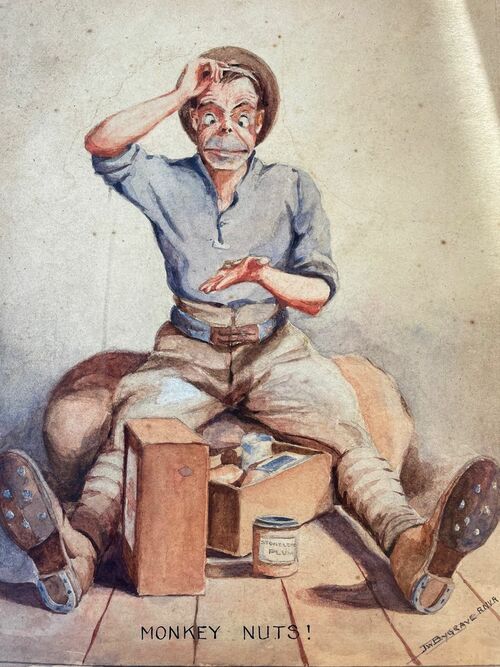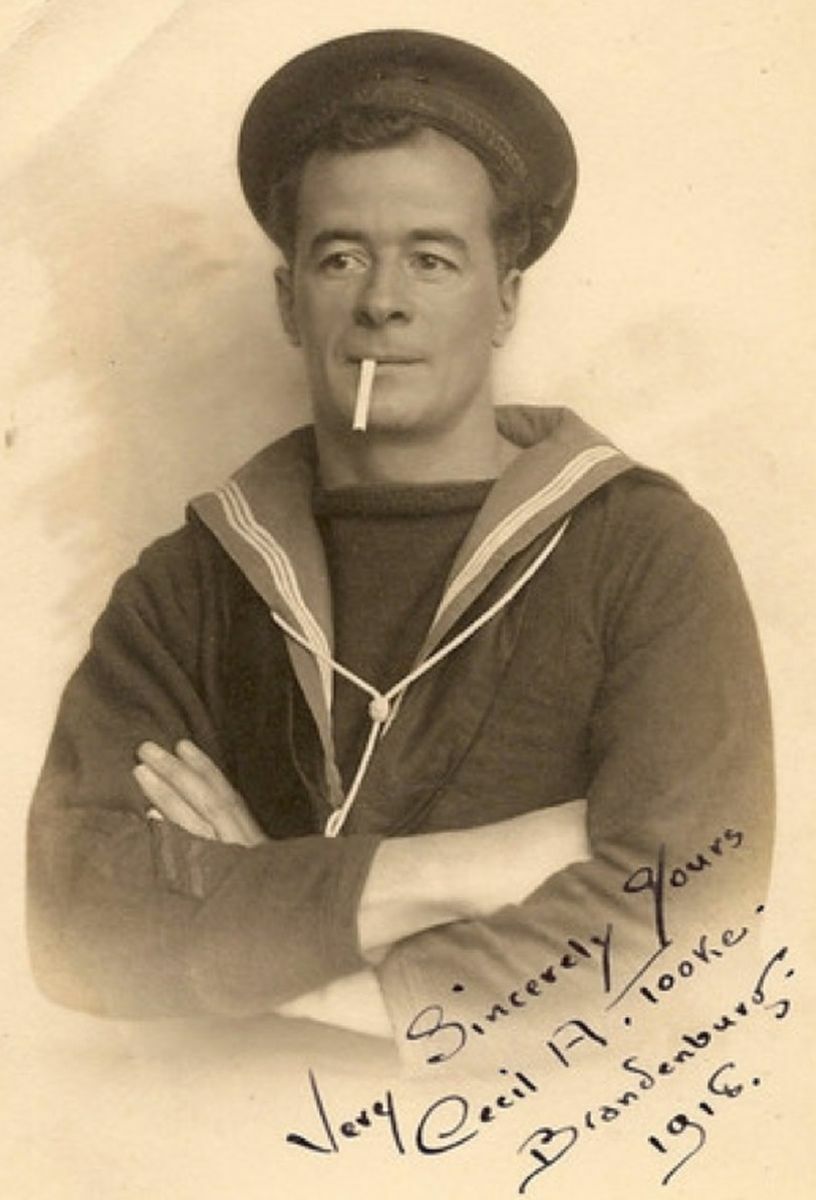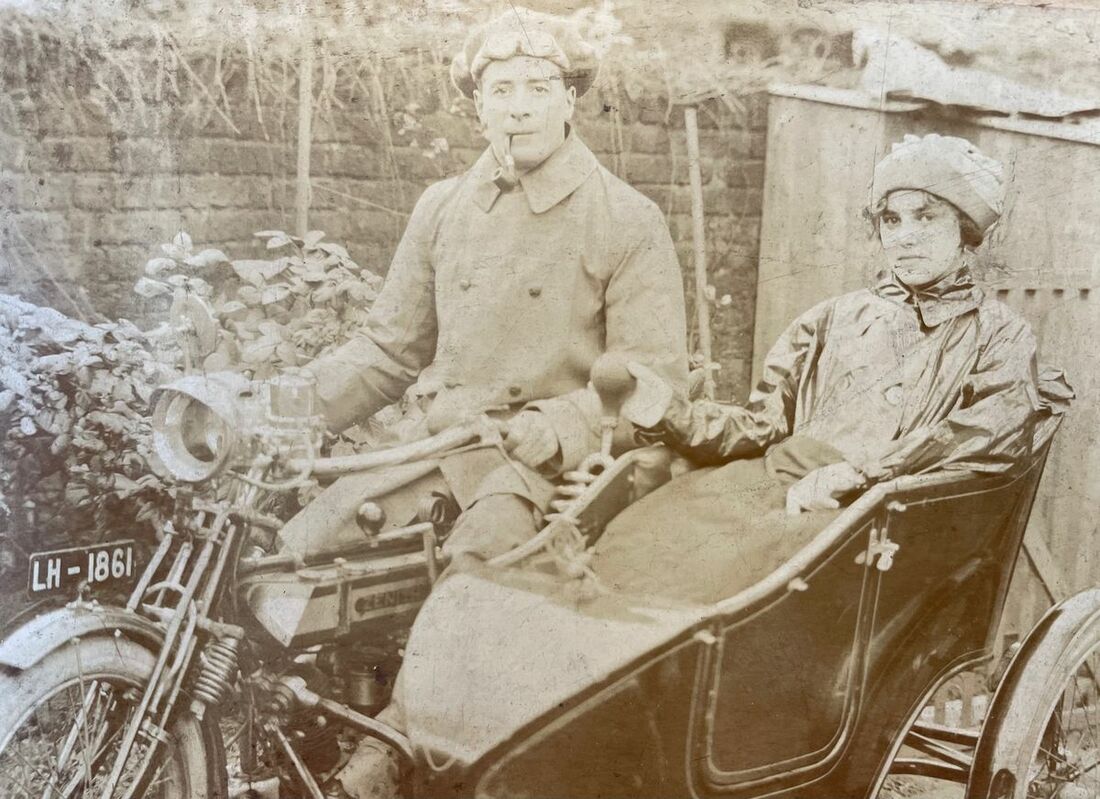Auction: 23001 - Orders, Decorations and Medals
Lot: 322
Sold by Order of a Direct Descendant
A remarkable Great War Prisoner of War's Medal of the Order of the British Empire group of five awarded to Able Seaman C. A. Tooke, Royal Naval Volunteer Reserve
A pre-war artist and illustrator, and rating in the London Division of the 'Wavy Navy', he was embarked for Holland in October 1914 as a dispatch rider for Hawke Battalion in the Royal Naval Division and, in common with the majority of his comrades, was taken Prisoner of War
Throughout his ensuing time as a captive at Doeberitz, outside Berlin, he gained notoriety on a number of counts, not least for designing the camp's coat-of-arms: one of the quarters depicted three cartridges to represent three of his comrades who were shot by their guards and another a British rating tied to a post - a much favoured German punishment
The coat-of-arms duly went into print as a postcard and many thousands were sold for the benefit of British camp funds, Berlin jewellers even using the design for enamelled brooches, pendants, and cigarette cases. And it took the Germans a full year before the real truth behind Tooke's 'quarters' finally dawned on them. They were not amused
Such joyous antics aside, Tooke also sent coded postcards to his sister, detailing enemy troop movements and other valuable intelligence, clandestine work that surely contributed to his award of the Medal of the British Empire
And when, in 1918, the Kaiser commissioned the famous German artist Arthur Kampf to undertake a portrait of a typical 'Jack Tar', it was Tooke who was chosen as the sitter. The finished portrait eventually appeared at auction in Hamburg in the 1930s, when it was purchased by the British Consul-General for inclusion in the Government's Art Collection
There, like too many state-owned works of art, it may have lain long forgotten but in 2021 - and full marks to him - Rishi Sunak, then Chancellor of the Exchequer, had it hung in his offices in Downing Street
Medal of The Most Excellent Order of the British Empire, Military Division, silver, on original pin, in its John Pinches, London case of issue; 1914 Star, rosette upon riband (L/23321. C. Tooke, A.B. R.N.V.R. Hawke Bttn. R.N.D.); British War and Victory Medals (L.2-3321 C. Tooke. A.B. R.N.V.R.), minor official correction to start of number on BWM; Royal Naval Volunteer Reserve L.S. & G.C., G.V.R. (2/3321. C. A. Tooke, A.B. London Div. R.N.V.R.), these last four mounted as worn, good very fine (4)
Medal of the Order of the British Empire London Gazette 14 February 1919:
'For valuable services whilst Prisoners of War in Germany in promoting the welfare of their comrades.'
Cecil Arthur Tooke was born in Chelsea, London on 6 October 1880 and, in addition to his work as a watermarking artist and illustrator, was an early member of the "Wavy Navy", having joined the London Division of the R.N.V.R. in November 1903. No doubt otherwise busy with his role as proprietor of the Savoy Studio, Tooke stood down from his naval commitments in 1913.
Recalled on the outbreak of hostilities in August 1914, in the rank of Able Seaman, he was drafted to Hawke Battalion, Royal Naval Division, lying about his age on his enlistment papers, stating that his date of birth was 22 November 1884. Duly embarked for Antwerp, as a dispatch rider, he was among those captured there in October.
Incarcerated in Doberitz prisoner of war camp, outside Berlin, his skills as an artist were quickly in demand, not least for the camp's newsletter, The Link. But as evidenced by his early propaganda coup with the design of the camp's coat of arms, he was not averse to taking risks.
The Coat-of-Arms
Tooke related the story his goon-baiting masterpiece in a post-war article:
'The density of the average German mind - the complete lack of imagination, initiative and humour - must have struck most of the men, who, like myself, spent many weary months among the Huns. "Mad Englanders," they called us, because we sought relief in jest and joke.
"Fritz can't see a haystack at the end of his nose," the boys of Doeberitz, where I spent four years if captivity, used to say. The comedy of the Doeberitz coat-of-arms proves this.
In November 1914, I designed a coat-of-arms to interest the boys in the camp, the quarterings of which had, for them, obvious meanings.
In one quarter I drew three cartridges representing three prisoners who were shot while clamouring for food outside the cookhouse by the guards. Another quarter depicted a sailor tied to a post - a favourite German punishment … '
Tooke continues:
'Underneath I placed Alfred Lester's great phrase, "Always merry and bright."
There is no doubt that this inscription led the Germans to imagine that the whole design was a testimonial to the benefits of life at Doebernitz, for to my amazement not only did the guards ask me to draw the coat-of-arms for them, but even Colonel Alberti, the camp commandant, who sent for me one day, said how much he liked the design and asked me to do one for him.
I drew a special picture in colours and seized the opportunity of asking permission to have the design printed, which was readily granted. Not only were many thousands of cards sold for the benefit of our funds, but Berlin jewellers used the design for enamelled brooches, pendants, and cigarette cases.
For twelve months the Doeberitz coat-of-arms enjoyed unique popularity. Then came the crash. The German War Office suddenly became aware of the real meaning of the design through a small reproduction in an English newspaper, with an inscription to the effect the Germans evidently could not see then poignancy which lay behind the design.'
All hell broke loose, the commandant ordering the destruction of all printed versions of the coat-of-arms, together with any objects bearing its likeness. But as Tooke later happily recounted, one version remained in view for the duration of the war, namely on a rating who had the offending coat-of-arms tattooed on his arm.
Coded postcards
The story behind Tooke's coded postcards to his sister is explained by his son, in a letter to the Imperial War Museum:
'To understand this, you must know the full story of my father's involvement in sending information with regard to German troop movements.
As he sent his [art] work on postcards home on a regular basis, he devised a scheme whereby he laminated the information between card which he used for his drawings.
All his drawing card was made up from old letters and Red Cross parcel material glued together with flour and water, then pressed between the boards under his mattress.
However, to get the information back to England on what - and how he was going to do it - was the problem.
Luckily, he had a sister who was extremely intelligent, and he knew that if he sent her a nonsense letter she would not think he was insane, and would follow the instructions in it.
So he sent this letter to his sister, Mrs. Daisy Heighton. With hindsight, it is easy to read 'between the lines' of this letter, but it must have been a bit of a shock to receive it and to follow the instructions through.
'A little story translated from the French by electricity'? Electricity at the time was something semi-magical, so this alerted her to think it was an extra special letter to do with French P.O.W.s.
The section about the bridge means, of course, the old Somerset House. He was told, I believe by a fellow P.O.W., where he should arrange for the information to be delivered, and this is recorded in the directions re. the library.
'A good postcard wasted' means that the next post card will have to be destroyed to gain access to the information.
Anyway, it worked, and several times information from both the British and French P.O.W.s was passed this way to the authorities.'
Sitting for the Kaiser
As cited above, it was at the Kaiser's behest in 1918 that Tooke was selected by the famous German artist Eric Kampf (1864-1950), to sit for a portrait of a 'typical English sailor'. A similar portrait was also commissioned of a typical English 'Tommy', namely Trooper C. G. King of the Royal Horse Guards. King is quoted in a Daily Mail feature published on 25 September 1936:
'The Daily Mail late last night found in London the English soldier whom Herr Kampf, the famous German artist, painted 16 years ago.
He is Mr. C. G. King, ex-trooper of the Royal Horse Guards and now chief inspector of the Canada Life Assurance Co., St. James's Square, S.W.
Herr Kampf painted Mr. King as a typical English prisoner, and, as announced exclusively yesterday in the Daily Mail, has sent his son to England with the original portrait to find him …
Mr. King was selected from a prison camp as a typical English soldier. His friend, Mr. C. A. Tooke (now living in Blackheath, S.E.), of the Royal Naval Division, another prisoner of war, who had been captured at Antwerp, was chosen as a typical English sailor.
Mr. King said:
"Herr Kamp's studio was in the German Royal Academy, most of which was then being used as a temporary hospital. I well remember, as I stood for two hours in the morning and two hours in the afternoon while my portrait was being painted, listening to the groans of the wounded in the rooms adjoining, and seeing the limbless and heavily bandaged Germans being wheeled up and down the corridor outside.
After several sittings we three became friendly and hatched an elaborate plot to escape. The attempt was a miserable failure …" '
Tooke's striking portrait in oils was eventually placed with an auction house in Hamburg, in the early 1930s, and it was purchased by Joseph Pyke, then Consul-General. It was then loaned to the Ministry of Works from 1952, before becoming part of the Government Art Collection. And - as cited above - it was recently chosen by Rishi Sunak to hang in the corridors of Downing Street.
Tooke was repatriated in December 1918 and the award of his Medal of The Most Excellent Order of the British Empire, Military Division, was announced in February 1919.
Discharged in the following month, he was also a recipient of the Royal Naval Volunteer Reserve's L.S. & G.C. Medal, which award had been approved back in March 1918.
He died in Orpington, Kent on 12 April 1966.
Sold together with the following original archive including:
(i)
His Doeberitz 1914-16 P.O.W. Badge, silver (reverse marked 'Silber 990') and enamel, with the motto Always Merry & Bright, with his own designs, as manufactured in Germany by the authorities.
(ii)
A striking and high-quality large-format charcoal portrait of the recipient, signed 'H. Mowbray, Dyrotz, 26.8.16', this glazed and framed, overall 700mm x 590mm.
(iii)
A number of original photographs of the recipient.
(iv)
Original programme of The Foolies, put on at the New Doeberitz Empire, March 1918, the programme designed by Tooke and with him as overall Director, together with a number of his sketches.
(v)
Watercolour painting by Tooke, sent to his wife, with Doeberitz postmark, depicting the home he hoped they would have after the conclusion of hostilities.
(vi)
Watercolour of a Prisoner, entitled 'Monkey Nuts', by J. W. Bygrave, another contributor to The Link.
(vii)
A USB drive containing a series of newspaper cuttings and his illustrations from his time as a P.O.W.
Subject to 20% VAT on Buyer’s Premium. For more information please view Terms and Conditions for Buyers.
Sold for
£2,200
Starting price
£550


